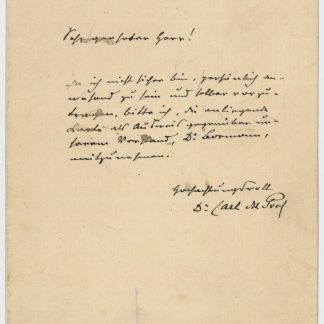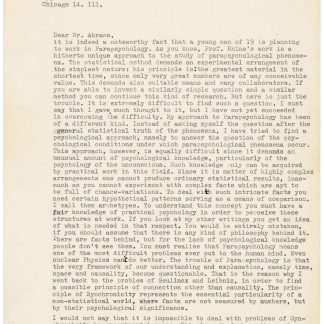Typed letter signed ("C. G. Jung").
4to (293 x 209 mm). 1½ pages on 2 ff. In English. On headed stationery.
€ 2,500.00
To the American parapsychologist Stephen Irwin Abrams on the practical use of archetypes and the difficulties of parapsychology, whose study makes "the very framework of our understanding and explanation, namely time, space and causality, become questionable".
It is a noteworthy fact that a young man of 19 is intending to work in parapsychology, Jung tells his correspondent; Professor [Joseph B.] Rhine's work is a hitherto unique approach to the study of parapsychological phenomena, but he notes that the principal drawback to pursuing a comparable "statistical" method is finding a similarly simple question to ask. Jung himself gave much thought to it, but has not yet succeeded in overcoming the difficulty. He has taken a different approach: instead of focusing on the statistical truth of the phenomena, he has tried "to answer the question of the psychological conditions under which parapsychological phenomena occur. This approach, however, is equally difficult, since it demands an unusual amount of psychological knowledge, particularly of the psychology of the unconscious. Such knowledge can only be acquired by practical work in the field", and the results are "complex facts which are apt to be full of chance-variations. To deal with such intricate facts you need certain hypothetical patterns serving as means of comparison. I call them archetypes". Suggesting his correspondent read up on practical psychology, he stresses that archetypes are not philosophical constructs, but based in fact, before warning him that parapsychology is one of the hardest problems ever put to the human mind, more complex than nuclear physics, because it calls into question our very understanding of space, time and causality. He moves on to discuss the relative merits of the experimental and psychological approaches to synchronicity.
Stephen Abrams was at the time attending the Parapsychological Laboratory at Duke University under Professor J. B. Rhine and planned to work on the experimental confirmation of Jung's theory of synchronicity. He moved to Britain in 1960 to work on an extra-sensory perception at Oxford and head its parapsychology laboratory.
Provenance: Stephen I. Abrams (1938-2012); acquired privately, July 1980.
Three ink corrections; slight damage to edges.







